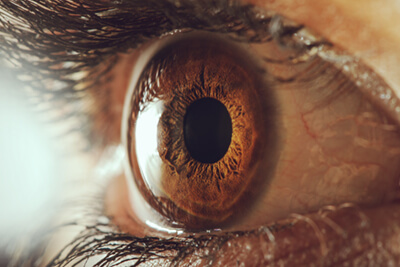Cornea

The cornea is the clear, front part of the eye that provides a protective layer. It plays an important role in your vision. The cornea provides approximately 2/3rds of the refractive power (ability to focus or bend light) of the eye. In addition, along with the sclera (white part of the eye), the cornea serves as a barrier against dirt and germs and helps filter out some of the ultraviolet light from the sun.
If the cornea is damaged by infection, disease, injury, or inherited disorders, you can develop permanent scarring and loss of vision.
Common diseases that can affect the cornea:
- Corneal erosions or Recurrent Erosion Syndrome – Erosions of the cornea are a type of abrasion or scratch that occurs typically without injury, but tend to repeatedly occur in patients who have previously suffered an injury to the cornea. For example, if you were ever poked or scratched by a fingernail you initially suffer an abrasion (scratch on the cornea), but are at risk to develop spontaneous erosions (scratches) in the future. Abrasions are extremely painful and cause watering, redness, light sensitivity, and blurry vision. Time away from work is often necessary to recover and treat these erosions. There are both medical and surgical treatments to manage and prevent recurrent erosion syndrome.
- Corneal Ulcers (infections of the cornea) – Anyone can suffer an infection of the cornea, but patients who are most prone to develop corneal ulcers are contact lens wearers, patients who are immunocompromised, have very dry eyes or cannot close their eyes completely. Corneal ulcers are very serious infections that without proper treatment, can lead to loss of the eye and permanent blindness. Viruses, bacteria, fungi (molds), and other organisms can attack the cornea. It is important to seek immediate care by an eye provider if you develop a painful red eye and especially if you wear contacts. Over wearing contacts, sleeping in contacts, swimming and showering in contacts puts you at risk for corneal ulcers.
- Dry Eye Syndrome – dry eye syndrome (DES) is a general term used to describe patients who have inadequate tears or oil layer on the surface of the cornea to maintain the health of the cornea. A healthy tear film is important for crisp vision. DES is becoming more and more prevalent due to the increased number of screen devices and time spent on computers and monitors, which leads to decreased blinking and eventually contributes to blocked oil glands. At Eye Consultants of North Dakota we offer the latest in dry eye therapy, starting with a detailed and thorough history and evaluation of your tear film, tear production and tear quality.
- Dystrophies – Fuch’s dystrophy is the most common corneal dystrophy in the United States, affecting approximately 2% of individuals over the age of 60. Fuch’s dystrophy affects the inner layer of the cornea, called the endothelium and is a slowly progressive disease that can lead to blurry and foggy vision. Some patients with Fuch’s dystrophy will have such blurry vision that they will require or be considered for a corneal transplant, called a DMEK (Descemet’s Membrane Endothelial Keratoplasty) or DSAEK (Descemet’s Stripping Automated Endothelial Keratoplasty). DMEK or DSAEK are types of corneal transplants that allow just the inner layer of the cornea to be replaced by a donor endothelial layer. These advanced corneal transplants allow for faster recovery and have excellent results. The latest corneal transplantation is offered at Eye Consultants of North Dakota by Dr. Anne Keating.
- Keratoconus is a type of corneal disease that causes ectasia of the cornea. This means that the shape of the cornea (which is typically spherical) is abnormal and becomes irregular, steeper and thinner than normal. This disease typically affects both eyes and starts at a younger age. Most patients with keratoconus are diagnosed in their teens or twenties, although milder forms of the disease can be recognized much later. Keratoconus can be a stable or progressive disease, meaning it can either stay the same over time or can progressively get worse with time. The treatment for Keratoconus varies, depending on the severity of the disease. In early stages, it can be treated with contact lenses (usually hard contact lenses). Cross linking is a procedure that helps strengthen the cornea in patients with Keratoconus that prevents it from progressing. In more severe forms of Keratoconus, a corneal transplant is necessary to improve and restore vision. At Eye Consultants of North Dakota, we perform frequent evaluations for patients with Keratoconus to determine the best course of treatment for each patient.
Corneal Transplants
All types of corneal transplantation available are offered at Eye Consultants of North Dakota, depending on your diagnosis. Dr. Anne Keating specializes in corneal transplantation as well as medical treatment for corneal diseases and would be happy to see you for any corneal problem or to discuss the benefits and alternatives to surgery.


